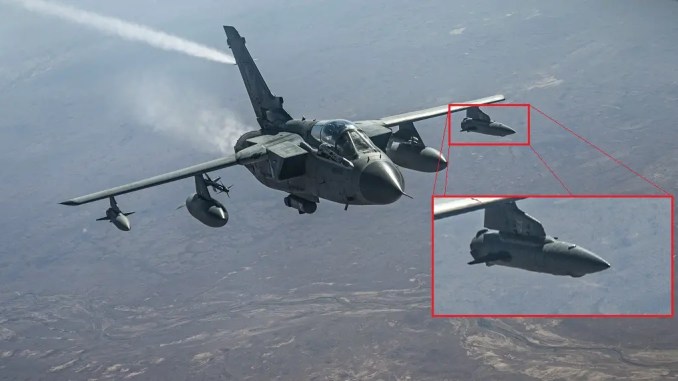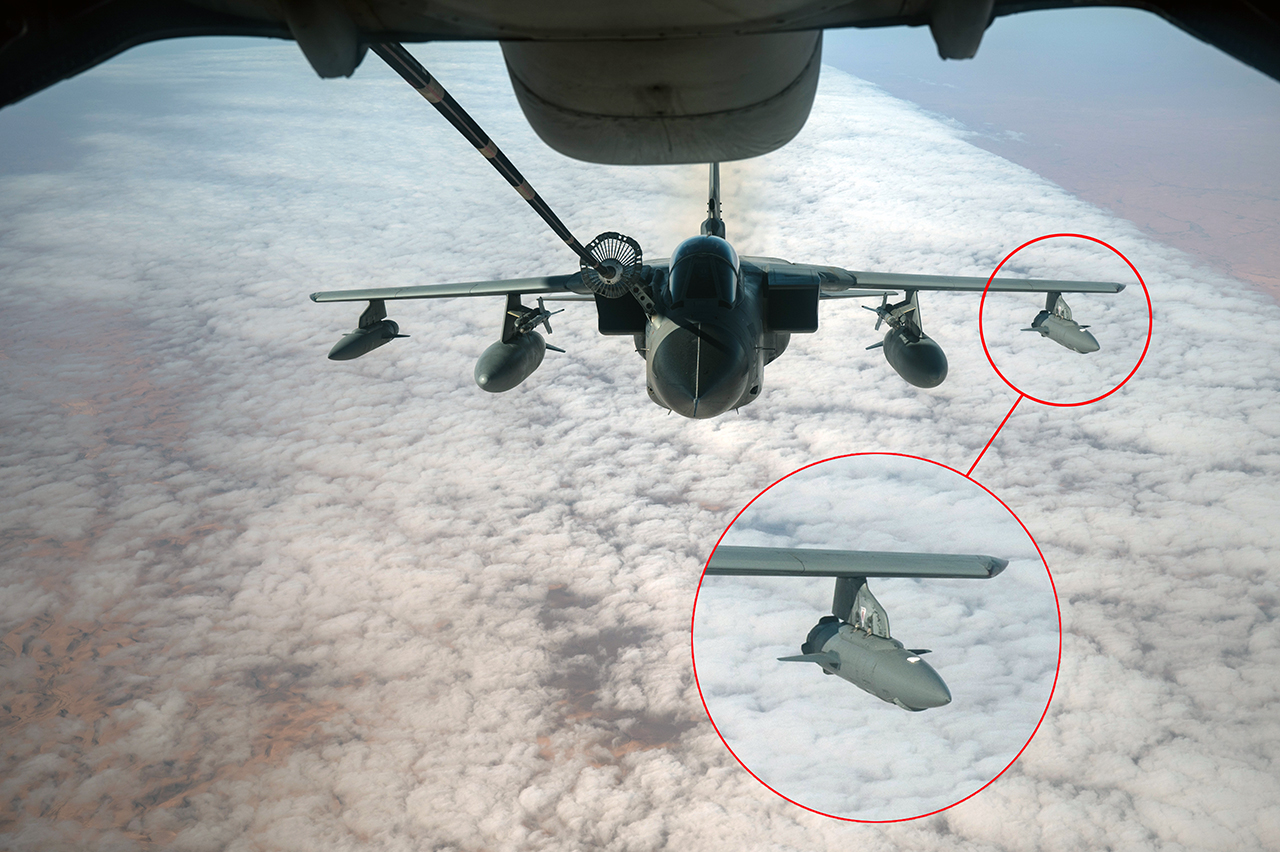
An Italian Air Force PA200 Tornado flies in the U.S. Central Command area of responsibility Nov. 23, 2020.The PA200 provides a tactical air strike and air superiority capability during missions for U.S. and Coalition forces. (U.S. Air Force photo by Staff Sgt. Sean Carnes - highlights by The Aviationist)
Images released by the U.S. Air Force Central Command show that the Tornado IDS of the Italian Air Force are flying with the BOZ-102 Enhanced Capability self-defense pods, rarely seen in official photos.
A few days ago, we wrote about the Tornado IDS of the Italian Air Force tasked with Intelligence, Surveillance and Reconnaissance (ISR) missions in support of Operation Inherent Resolve. A detail that went unnoticed at first in the photos provided by the ItAF and was visible again in some higher resolution photos published by the U.S. Air Forces Central Command is the use of the BOZ-102 EC podded self-protection system.The BOZ-102 is an Italian-specific variant of the Saab BOZ-107 Countermeasures Dispenser System originally developed for the RAF Tornado aircraft, with another variant called BOZ-101 developed for Germany, used to protect the aircraft from radar and IR-guided missiles by dispensing chaffs and flares. The BOZ-102 Enhanced Capability is the evolution of the original pod, designed to detect missile and laser threats for a 360° cover around the aircraft.
According to Saab, “BOZ-EC implements the Saab CIDAS-100 Compact Integrated Defensive Aids Suite into the BOZ pod. The countermeasures dispensing is characterized by the flare cocktail capability, designed to defeat modern InfraRed- -guided threats. The dispensing system also caters for dispensing or chaff and Expendable Active Decoy (EAD). BOZ EC contains five pyrotechnical BOP-L 39 dispensers and four Missile Approach Warning (MAW) sensors in the aft section. The dispensing can be performed forward and downward or sideways in two adjustable directions.”

A U.S. Air Force KC-10 Extender fuels an Italian PA200 Tornado above the U.S. Central Command area of responsibility Nov. 23, 2020. The KC-10 provides aerial refueling to U.S. and coalition aircraft in support of Operation Inherent Resolve, the NATO Resolute Support Mission and Operation Freedom’s Sentinel. (U.S. Air Force photo by Staff Sgt. Sean Carnes)
The system is reportedly in service with the Italian A-200C and EA-200B Tornado fleet since 2008, when it was first ordered to address an urgent operational requirement to enhance the protection against shoulder-launched IR-guided surface-to-air missiles in Afghanistan, where a detachment of four aircraft was being deployed in a reconnaissance role with the RecceLite pod. The system is considered plug-and-play without specific integration activities as, after the refurbishment and upgrade, the pod’s mass and center of gravity are still within the clearance tolerances of the original design and there are no changes to the aircraft interface.

An Italian A-200C Tornado IDS at Ahmed Al Jaber Air Base in Kuwait. (Photo: Troupe Azzurra/Italian Air Force)
Until now, the pod has been rarely seen under the Tornado’s wings and only photographed by some spotters. For this reason, the shots you can find in this article mark the first time the system is shown in official photos. As far as we can see in the photos, it looks like that the Tornado IDS is carrying both a standard BOZ-102 and a BOZ-102 EC, in addition to its auxiliary fuel tanks, RecceLite pod and AIM-9L missiles.
The integration of Missile Approach Warning Systems (MAWS) became increasingly common in the last two decades to counter the increased threats from IR-guided missiles. As Radar Warning Receivers can only provide warning about radar-guided missiles, the crews had to constantly use their eyes to look around the aircraft for incoming IR-guided missiles, but sometimes this is not enough, especially if the missile’s trajectory is hidden by the airframe.

The BOZ EC pod. (Image credit: SAAB)
That’s when MAWS systems come in handy. The UltraViolet sensors employed by these systems detect the radiation in solar blind spectrum from incoming missile’s exhaust plumes and signals it to the crew, often with simultaneous automatic reaction by the countermeasures dispenser.
The first air assets to receive the MAWS systems were the helicopters, as their low altitude and speeds leave them more exposed to surface-to-air threats, but soon these systems were fitted also to cargo and fighter aircraft and now are being fitted also to more strategic assets like tankers. While initially MAWS where integrated in pods, like the BOZ EC of the Tornado IDS/ECR or the Terma AIRCM of the Tornado GR4, or pylons, like the Terma PIDS+ and ECIPS+ used by European F-16A-MLUs, the sensors are now being integrated directly into the airframes, like we reported for the F-15QA, F-15EX and M-346 LFFA.

Italian Tornado IDS Aircraft Are Flying Anti-Daesh ISR Missions With Enhanced Countermeasures Pod
Images released by the U.S. Air Force Central Command show that the Tornado IDS of the Italian Air Force are flying with the BOZ-102 Enhanced Capability


